
#Afterglow: Notes on Transmediale 2014
Dieser Artikel ist älter als ein Jahr!
Throughout the Cold War the curved, oyster-like roof of the Haus der Kulturen der Welt cast a dramatic shadow across the divide of the Berlin Wall. Designed by the American Hugh Stubbins, and completed in 1957 on a site close to the Reichstag, the modernist building was always intended as a symbol and beacon of freedom. As the name suggests, it was built as a venue to showcase ‘cultures of the world’, and over the years played host to a long line of prominent artists, scientists and intellectuals.
Following major renovations in 2006/7, the building today continues to offer an important international stage. At the start of each year, with the city invariably draped in snow, the building again functions as a beacon, playing host to new critical visions of transmediale, the Berlin-based festival exploring contemporary and future conjectured connections between art, culture and technology.
Afterglow
The festival has a 27-year history, offering 20,000 visitors per year a rich programme of exhibitions, conferences, screenings, performances and culture hacks. The annual gathering has become an essential fixture in the calendar of an international community of media art professionals, artists, activists and students. Each year the festival selects a theme as an overarching framework for the contributions of hundreds of artists, media activists, researchers, designers and creatives. Following on from last year’s theme, Back When Pluto was a Planet, which considered how conceptions of the world are transformed by technology, the festival this year – in the shadow of deepening ecological strife and the ubiquity of surveillance within democratic countries – chose the ironic title of Afterglow:
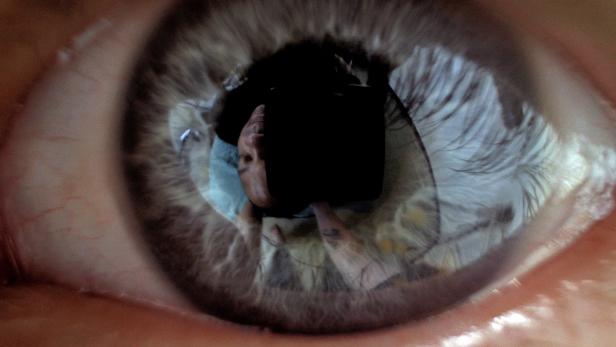
© Nadav Assor
Framed Snowden
Sitting in numerous panels at the festival you might well have imagined somewhere in the building hung a huge framed portrait of the NSA whistleblower Edward Snowden. Of course, with the venue just a stone’s throw from the German parliament and government buildings, the recent revelations of the phone tapping of the German Chancellor were certainly present to many minds.
One keynote panel, Art as Evidence, brought together the filmmaker Laura Poitras, whose direct engagement with Edward Snowden has led to the revelations appearing in Der Spiegel, The New York Times, and The Guardian; the security researcher and hacker, Jacob Appelbaum, well-known for his work with the Tor project, offering a free, anonymous software network; and the artist Trevor Paglen, whose meticulous tracking and recording of secret military sites and hardware has come to blur the lines between science, art, and journalism.
Given the sensitive nature of the work of these speakers there was inevitably a charged atmosphere to the packed auditorium of the Haus der Kulturen. The speakers shared their experiences regarding issues of access to the unclassified, the sense of urgency to communicate about processes and structures of information, and the practical and ethical complexities and dilemmas of visualizing the invisible. Arguably the methods of the artist forge unique opportunities to respond to these difficulties. Obsessive, detailed research and a willingness to take risks, combined with the creative handling of gathered evidence, means that the making of films, texts and artworks can often help reveal the discrepancies and paradoxes of geopolitical surveillance and control.
The materiality of secrecy
Trevor Paglen, in particular, brings into focus the materiality of secrecy. The often abstract-sounding covert activities, such as ‘rendition’, must of course have their basis in practical, tangible processes such as transport, schedules and supply lines. The very same ‘stuff’ that makes up the everyday equally underlies the secret world. And it is amongst the mundane that the fault lines emerge and that the artist as researcher, or the researcher as artist, can play a particularly innovative role.
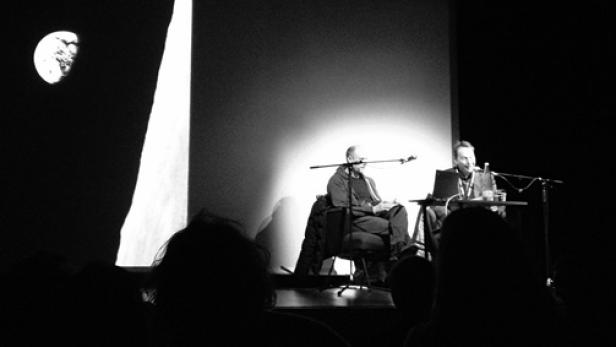
© Sunil Manghani
The conversation turned to Paglen’s photograph taken in Yosemite National Park, a site with a long history of photographic interest, being iconic of the American West. Yet in Paglen’s case there is a twist. The romantic landscape is still present, yet his picture of the night sky (which appears as if in daylight) also captures a secret imaging satellite.
As Ryan Bishop suggested, the photograph is a form of self-portrait, with the satellite capturing Paglen’s own image where he has set up his camera. It is a self-portrait where two cameras look back at each other and Paglen as subject is eerily lost. The post-human condition whereby machines take pictures for other machines (and/or other species), is developed further in Paglen’s recent work of The Last Pictures, in which he launched a set of images into space as a kind of stowaway cargo on the side of a communications satellite – and which will now orbit the earth well beyond the life of humankind.
On Software and Sovereignty
A further keynote address, specially convened by the Winchester School of Art (UK), a key partner of transmediale, was presented by Benjamin Bratton, who recently published a stinging critique of TED talks with The Guardian. As Professor of Visual Arts and Director of The Center for Design and Geopolitics at the University of California, San Diego, Bratton works at the intersections of contemporary political theory, computational media and infrastructure, and architectural and urban design.
His forthcoming book, The Stack: On Software and Sovereignty, is set to make a real impact through its examination of the political geography of cloud computing, massively-granular universal addressing systems, and alternate models of ecological governance. Bratton posits a six-layer stack or architecture to our contemporary mediated experience: Earth, Cloud, City, Address, Interface and User.
The modeling of the stack will take on increasing significance as we face up to how the bare resources of the earth underpin the globalized on- and offline experiences of individual lives. We have already begun to hear the phrase of the ‘internet of things’, whereby all of the hardware that currently surrounds us will taken on dynamic, networked and ‘intelligent’ properties. In the same way we can locate and interact with individual mobile communications across the globe, we will soon regularly be interacting with objects, and objects themselves interacting with objects.
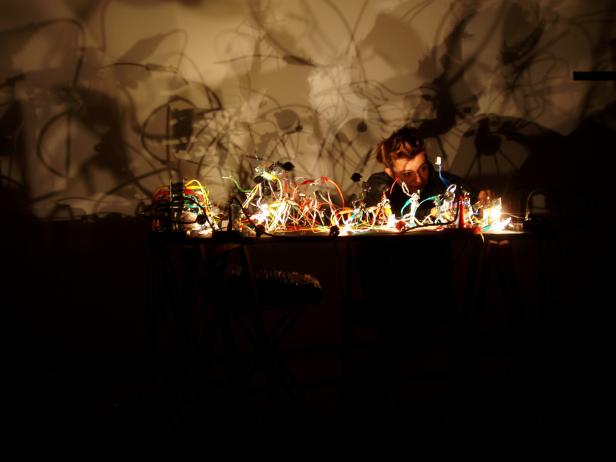
© Aero Peru
The Afterglow of the Mediatic
The relationship between media technologies and the ‘earth’ layer of the stack was explored with a further panel, The Afterglow of the Mediatic, conceived by Professors Ryan Bishop and Jussi Parikka at Winchester School of Art. The panel discussed how the ethics and politics of waste and mining directly relate to issues of data and hardware, and how issues of labour, geopolitics, economics, and media are all intricately bound, yet difficult to tease apart.
One particular presentation, by Sean Cubitt, Professor of Film and Television at Goldsmiths (University of London UK), was cheered by all those listening in the auditorium. Cubitt reminded the audience how the oceans were once considered an infinite resource, outside of capital constraints. We know now this is simply not true. Nonetheless, the environment is all too frequently considered through the lens of capitalism to be an external factor, with no direct cost.
Cubitt charted, through precise narrative and dramatic imagery, a catalogue of failures to fully comprehend our ‘natural’ resources. Our thirst for energy sources, whether oil, water, or uranium, have all had catastrophe impacts on millions of people’s lives. Cubitt declared how the ‘old’ impoverished working class still exist, yet today they work to ‘destroy overproduction’, to handle the waste and hazardous materials that leak out from the production and consumption of new technologies. He considered the notion of the cyborg, which we once thought of as the human with computer implants, yet now find to be a vast computer with humans embedded in it.
The exaltations of the crowd toward Cubitt were a genuine response to his powerful critique of present global conditions. He concluded with a biting question: Why do give full rights to the ‘cyborg’ money markets (that now operate largely through computer-generated, algorithmic trading), yet not to the environment? Cubitt was clear: to do so ‘would change us deeply, but it is a change we need’.
This is Tomorrow
Throughout the days of the festival the Haus der Kulturen der Welt was home to a diverse crowd. Artworks buzzed and decayed while lecture and seminar audiences circulated between the different rooms around the venue, and gazed up at the live stream in the main foyer. Performance artists from around the world enthralled those gathered around café spaces and a daily programme of film screenings presented both historical and contemporary works.
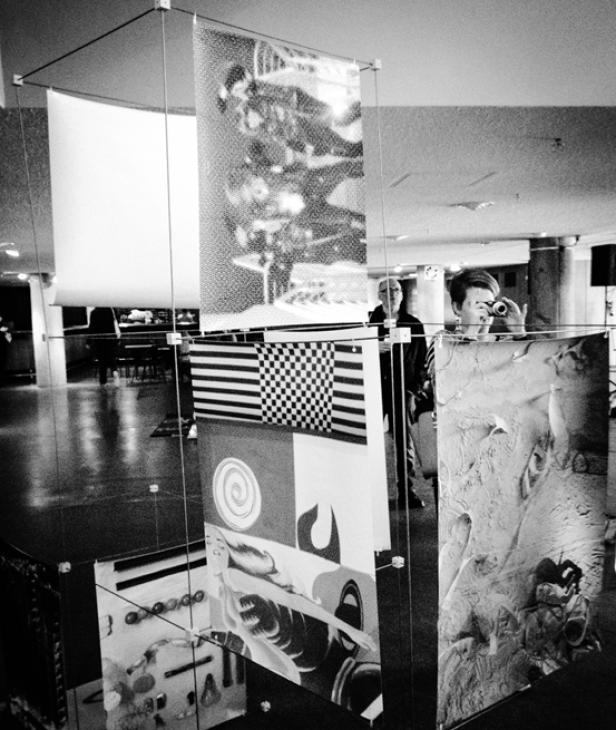
© Sunil Manghani
The project had involved a delicate process of both archival research and practical making to help get beyond the largely print-based recordings we have of the exhibition. Despite the ease with which we can search online about an iconic event such as This is Tomorrow, all too often we find ourselves being returned to the same collection of well-worn images and pithy, crowd-sourced sentences. As the students hit against the limits of accessing the past they experimented with ways of making as a means to ‘know’ about the past, as well as to question our contemporary conditions, surrounded as we are with new technologies of imaging and 3D printers.
The original exhibition, This is Tomorrow, was held at the Whitechapel Gallery in London in 1956, the very same year the the Haus der Kulturen der Welt was being devised and built. The explicit modern intentions of both a London exhibition and a Berlin building grew out of the rubble of the 2nd world war, both offering bold visions of the future, of colour, dynamic forms and direct confrontation with the dilemmas of modern politics and mass, mediated culture. The rendering of This is Tomorrow at Transmediale this year was a most apposite reminder, then, of our ongoing history of making and remaking visions of the future, and our need to be ever vigilant to who we are today.

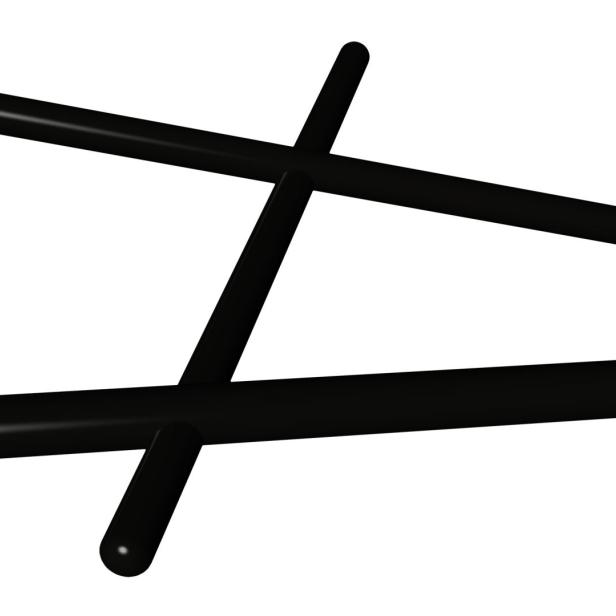
Kommentare